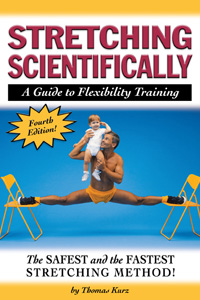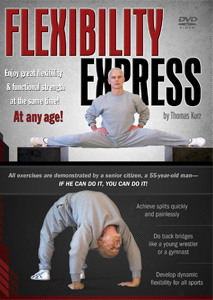by Thomas Kurz
I get many questions from martial artists on relation of gender to flexibility. Some men ask whether women are naturally more flexible—perhaps looking for an excuse not to try a rational stretching method. Some women ask whether my stretching method will work for them as well as it works for men—as if women’s muscles and nerves were so different from men’s as to require completely different stretches.
Question: I’ve seen your ad. How come there are no pictures of women doing the chair (or any) splits?
Answer: Because no woman took the trouble of sending a photo of her side split (lateral split, box split, Chinese split) between chairs. You can be the first.
But seriously—it appears that in martial arts there are even fewer women who undertake serious training than the small number of men who do. In other sports, such as gymnastics, the situation is different and many women gymnasts display such splits easily. This may have to do with the lesser quality of the majority of instructors in martial arts as compared to instructors of gymnastics as well as with the athletes’ selection process. Women gymnasts who are rationally trained by well-educated coaches have no need to study my book or video and so do not send me testimonials.
Question: Is it true that females are generally more flexible than males?
Answer: It is true only if comparing, for example, hip flexibility of the sexes in the general population, but it is not true for particular individuals and not necessarily true for other joints. Don’t you know men who are more flexible (in all major joints) than many women?
Females all over the world tend to have a greater range of motion in the hip joint and in the elbow than men (Alter 1996). They also have a greater range of extension of the lower back than men (Whitcome et al. 2007). But results of studies of differences in flexibility done in different countries may vary for other joints. For example, a study done in the U.S.A. by R. E. Koslow (1987) shows that 17- and 21-year-old women have greater range of motion than 17- and 21-year-old men in the shoulder, while a study done in Italy by F. Repice et al. (1982) shows the opposite. (Full references are in the fourth edition of my book Stretching Scientifically: A Guide to Flexibility Training.)
From observation of gymnasts—athletes who are both selected for flexibility and work a lot on flexibility—you can see that women gymnasts tend to be more flexible than men of the same skill level. It has to do with differences in the bone structure and perhaps with women gymnasts having more compliant ligaments and usually less muscle mass around all joints than men gymnasts.
Question: Is women’s ability to kick high much better than men’s?
Answer: If you refer to high martial arts’ kicks—delivering hard impact when kicking high—then, based on my observations, I would say no, it is not better. If you mean dance-like kicks, then women tend to show greater range of motion than men.
Question: I am a 30-year-old woman who has been taking ballet and jazz dance classes on and off throughout my life for enjoyment and in the past 2 years consistently as an aspiring professional. I have never been able to do a front split or a side split even as a child. I want to know if your methods will help increase my flexibility in regard to dance. For example, most technical dance kicks require an upright posture with a turned out straight leg from the hip with the pelvis tilted forward. Would following your method be appropriate for the kind of body alignments I need to achieve or would they work against my goals?
Answer: The method of stretching described in Stretching Scientifically and shown on videos Flexibility Express and Secrets of Stretching affects the neural control of muscles and in case of isometric stretching also strengthens muscles in extended positions. It works regardless of the form of your movements as long as the movements themselves are not injurious.
There is a possibility that the structure of your hips keeps you from achieving splits and no matter how well and how much you exercise you will not do a full split. In-depth information on this issue and on how to tell if this is the case is in Stretching Scientifically. (The test of hip joint’s structure is also shown on the videos Flexibility Express and Secrets of Stretching.) But as long as you feel that it is your muscles’ tension and not bone on bone contact that limits your range of motion, it means that you can improve.
Even if you are one of the few people whose hip structure prevents achieving splits, with a rational stretching method you can reach your full potential sooner and easier than with less effective methods.
References
Kurz, T. 2012. Flexibility Express. Island Pond, VT: Stadion Publishing Company, Inc.
Kurz, T. 2004. Secrets of Stretching: Exercises for the Lower Body. Island Pond, VT: Stadion Publishing Company, Inc.
Kurz, T. 2003. Stretching Scientifically Island Pond, VT: Stadion Publishing Co. Inc.
Whitcome, K. K., Shapiro, L. J., and D. E. Lieberman. 2007. Fetal load and the evolution of lumbar lordosis in bipedal hominins. Nature vol. 450, no. 7172, pp. 1075-1078.
This article is based on the Stadion book Stretching Scientifically: A Guide to Flexibility Training and on videos Flexibility Express and Secrets of Stretching. Get these titles now and have all of the info—not just the crumbs! Order now!



